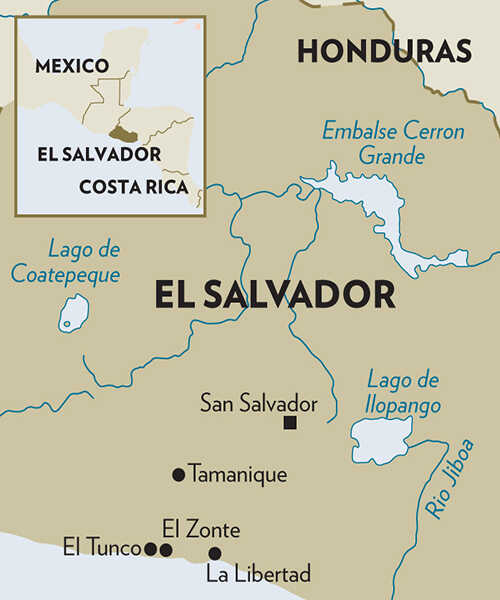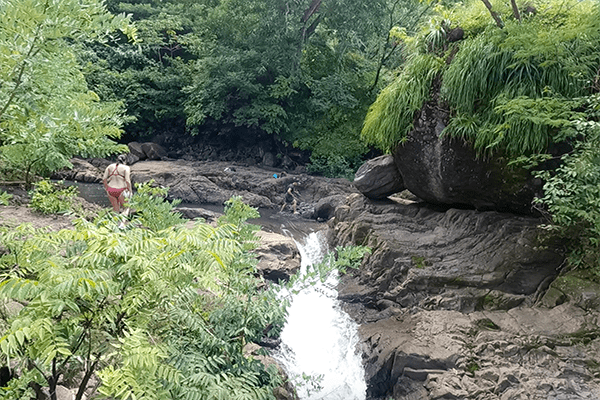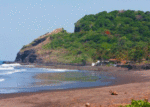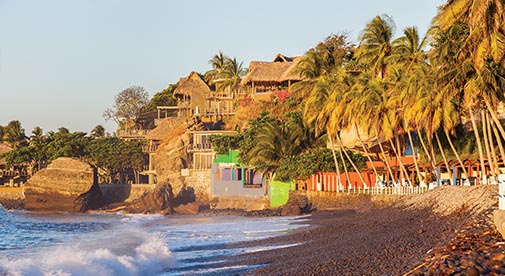El Salvador: Central America’s Undiscovered Frontier
El Salvador’s surf coast—a strip of palm-fringed oceanfront which runs about 30 miles west from the market town of La Libertad—contains more perfect surf breaks than is strictly fair.
Surfers in California and New South Wales would pledge their firstborn’s college money for just one of these black rock outcrops. Here, they punctuate the shoreline every mile or two.
Hardcore surfers see themselves as modern-day explorers in the mold of Livingstone or Shackleton. They’ve ridden waves breaking over icebergs in the Arctic, and off rusting shipwrecks in Namibia.
Three-week endurance hikes through malaria jungles or trackless Siberian tundra are all part of the allure. Anything for an empty wave and a viral TikTok roll.
They were the pioneers in El Salvador, drawn to its empty waves and rock-bottom day-to-day prices. But they didn’t keep it quiet enough. Someone always tells.
Now, as more and more people learn about it, a quiet, but ever-increasing buzz is growing around this overlooked tropical playground. With good reason. It’s a wonderland of al fresco rum bars, infectious laughter, and Latin rhythms pulsing in the salt air of a languid beachside evening.
No, really. It’s the quintessential picture of banana fronds, sultry glances, papaya smoothies, and salsa-dancing that comes to mind when you fantasize about how, this year, you’re going to ditch the cold, dark winter and split south of the border. And every month, that El Salvador buzz grows.
So, pity the poor surf pioneers. They’ll groan and roll their eyes as the first waves of merely adventurous travelers begin to arrive. They’ll gripe even more when the adventurous ones are followed by the curious, then the influencers and vloggers, and eventually the hordes.
But don’t pity the gnarled surfers too much. They’ll either move on, or wallow in their “I was there in ’96” bragging rights. Meanwhile, your decision is whether you want to be one of the adventurous ones to visit El Salvador now, or wait to be one of the masses.
The country has been hogging Central America’s allocation of media coverage lately, largely due to its president, Nayib Bukele, making bitcoin legal tender there. But more so because Bukele is actively seeking media coverage.
He started by declaring bitcoin as legal tender in El Salvador, followed by an announcement that anyone spending three bitcoin in the country would be granted permanent residency. That turned a lot of heads. He then followed up with a declaration that income or capital gains on bitcoin holdings will not be taxed. That raised a few eyebrows.
The press releases kept coming. Next was the installation of 50 bitcoin ATMs in the U.S. (allowing Salvadorans to transfer funds from the U.S. to El Salvador with minimal charges), followed by footage of a volcano-powered bitcoin mining operation in the mountains of northern El Salvador…
Suffice to say that Bukele knows how to keep the media’s attention.
All of a sudden, the country is in the public eye, and not because of gang violence or civil war. Those appear to be part of El Salvador’s past now, and the country has been at peace long enough for a generation to grow into adulthood without such fears.
The civil war ended in 1992. The gang violence which punctuated the period following it is decreasing rapidly, and is now mostly confined to an ever-smaller section of the capital city.
Right now, El Salvador is on the cusp of becoming a major expat destination. Bitcoin investors, miners, traders, and commentators are arriving in force.
They’re drawn to the country partly for practical reasons—the permanent residency offer is a good one—and partly out of sentiment. Bitcoiners have been waiting a long time for official endorsement of the alternative financial future they believe in.

Get Your Free Report on the World’s Best Places to Retire:
Learn more about the best places in the world to retire in our daily postcard e-letter.
Simply enter your email address below to sign up for our free daily postcards and we’ll also send you a FREE report on The World’s Top 10 Retirement Havens, plus access to over 10 more free reports. Our gift to you, on our favorite destinations.
El Zonte, the village where El Salvador’s bitcoin story originated, is a pilgrimage site for anyone emotionally invested in the notion of a post-financial, cryptocurrency-fueled utopia.
It’s a bit of a scene. My time there was spent rubbing shoulders with digital nomads such as Wayne Gregori—a 50-something bitcoin investor from San Francisco—to cryptocurrency podcaster Alex Gladstein, to Jack Kruse, an eminent Chicago neurosurgeon who is deeply committed to the future of bitcoin.
When I met Jack, he had just put an offer on a house in the village. He intends to move to El Zonte, set up a clinic, and divide his work hours between local patients (whom he vowed to treat for affordable rates—or even in return for Spanish lessons) and affluent medical tourists from North America, who will pay him in bitcoin.
That influx of bitcoiners has made something of a bubble out of El Zonte. It seems odd that a tiny village of some 150 families should boast at least two high-end hotels, despite not having a supermarket or a school, but such are the economics of beach towns with big media stories.
All that aside, it’s a sweet place to spend some time. Its beaches are rugged and rocky, with a few sandy spots in between where you can take a dip in the warm Pacific (although the waves and currents are strong, so be careful out there).
Clifftop homes perch above the water, and the land rises steeply from the sea’s edge up to the acid-green broadleaf forest that carpets the ridges and canyons of the interior. In the right light, you could mistake it for Hawaii, or some other Polynesian idyll.
Best of all are the two pupuserias in town, one on the main street, the other on the seafront. Neither of them is fancy, these are open-sided, tin-roofed joints, where you shout your order to the cook and a local kid runs to the store to bring you a bottle of cold Regia beer.
Dinner won’t cost you more than $6, even with a beer.
Opinion is divided over which place serves the best pupusas (flat discs of wheat tortilla stuffed with your choice of fillings). I liked both spots, but Roxana’s place down on the seafront came with a soundtrack of crashing waves, which possibly edges it. Dinner won’t cost you more than $5 or $6, even with a beer.
El Zonte is undeveloped and low-key for the most part. It’s a spot for going barefoot, meeting friends under a palm tree on the beach, and listening to the whoops and gurgles of tropical birds at sunset. If you feel the need for an upmarket evening, though, the Palo Verde hotel is eye-wateringly swish, with its uplit infinity pool, L’Occitane cosmetics in the restrooms, and boho-chic designer decor.

Property in El Zonte is, to my mind, pricey. Most of those three-bitcoin investments in El Salvador will be made in the village. As a consequence, beach homes—about the only thing you could hope to spend three bitcoin on in these parts—cost more than I think they should.
Nevertheless, once you get out of the immediate vicinity of the beach, and look a little farther uphill, things get more reasonable. $200,000 will cover a three-bedroom house once you’re away from the shoreline. Count on double that for somewhere within a half-mile of the sea. The real issue is finding a property built to international standards. I viewed one with Roman Martinez of Onda Real Estate (Ondarealestateelsalvador.com).
With three bedrooms, pool, garden, outbuildings, and luxury finishes, the property came with a separate apartment at the bottom of the lot that sleeps four (with its own kitchen and bathroom).
The asking price was $400,000, mainly due to its location just a stone’s throw from a spectacular secluded bay. (I made a video of the property that you can view at: IntLiving.com/Zontehouse)
The price reflected that the home was fully built, available, and ready to move into. That’s a rarity in El Zonte. Demand is outstripping supply, but opportunities abound. Land is available, developers are ready to build, all that’s missing is time. If you can wait for it to be built, your dream Salvadoran beach home could cost you less here than you’d ever imagined.
If you don’t have an emotional connection to the bitcoin project, though, there’s no need to confine yourself to the high-end properties of beachside El Zonte. The area surrounding the village is just as pretty, the beaches just as wild, and the prices are significantly lower. One more plus-point for Onda Real Estate is that Lexi Cross, one of its senior partners, is a New Yorker living in El Zonte, so there’s no language barrier to negotiate.
I’ll admit to being stunned by the property prices on the 15-mile stretch of coast between El Zonte and La Libertad. Stunned in a good way.
Can you still get three-bedroom ocean-view homes with garden, pool, and outbuildings in an affordable, warm country less than three hours’ flying time from the U.S., with good roads, excellent private healthcare, great food, and fast internet for less than $200,000? You can in El Salvador.
In fact, you can get all that for less than $170,000. That, in 2022, is incredible value. If you’re happy to live up in the hills, oh, a whole 20 minutes’ drive from the beach, the village of Tamanique is the gateway to a pristine forest park, spectacular waterfalls, and wonderful hiking country. Its colonial-style plaza is the perfect example of a neat, understated, sleepy town center, complete with palm trees, wooden porches, and Spanish-style house facades. Homes there go for less than $160,000.
If you’re tempted, don’t take my word for it, go see for yourself. A long stay in the area could cost less than a week in Florida (see sidebar), and you can spend a month checking out the local property market.
If you choose the colorful beach town of El Tunco as your base, Oceanside real estate (see: Oceansideelsalvador.com) has an office right on the main street.
The country has a way of getting under your skin; it’s addictive. For $25 a day, I could have hired a motor scooter in El Tunco and gone exploring, but something about the atmosphere of this groovy little surf town rooted me to the spot for longer than I’d planned. For decades, it’s been a weekend and vacation spot for the middle classes of San Salvador (the country’s capital city).

That’s an interesting setup, because although the bars, cafés, restaurants, and hotels you’d expect from a beach vacation town are there, El Tunco’s always played host to domestic tourism rather than international.
That detail gives the town a delightful sense of place—the food on offer is mostly local specialties, the beers are domestic (and very good, especially the local craft beer brand, Cadejo), and the rhythms you’ll hear from bars or street corners are salsa, cumbia, and rhumba rather than hip-hop or tech-house. In a world that’s becoming eversmaller and increasingly homogenized, that’s wealth beyond any spreadsheet.
El Tunco’s black-sand and cobble beach isn’t the standard tropical dreamscape, I’ll admit. Don’t hold that against it—the sunsets are dramatic and, once you’ve seen the light glittering off a billion grains of volcanic crystal, you’ll wonder what the fuss about white-sand beaches was about.
Wandering salsa bands play along the seafront.
Better than that is, as the evening turns to night, El Tunco livens up. Wandering salsa bands play along the seafront promenade, collecting $3 per song from those seated at the open-air bars. Dancing happens spontaneously—actual hand-to-hand partner-dancing— anywhere within earshot (including on the beach). It’s informal, hilarious fun, and nobody minds dancing with a wide-eyed foreigner.
Honestly, spend a weekend evening at El Tunco and you’ll feel like you’ve stepped into the Cuban scenes of Guys and Dolls.
Dancing under the stars to a salsa band, a couple of one-dollar shots of local tequila under your belt, and the sultry tropical air wafting the palm fronds overhead…fantasies are made of this.
This whole stretch of coastline looks a little like west-coast Scotland spliced with Polynesia—it’s a landscape of hardwood forest-topped cliffs plunging into wild ocean swell, pierced by jutting peninsulas and rocky shoals. Don’t expect languid turquoise bays and iced cocktails on a sun lounger. It’s rugged, and all the better for it. Think in terms of slugging a cold beer from a bottle, while you sit on a rounded boulder and watch the surfers get trounced by the surprisingly large waves at the surf spots between El Zonte and La Libertad.
All of the surf coast is linked to the capital by excellent roads, and slightly less excellent buses. Luxury long-distance coaches haven’t made it this far yet, so you’ll need to call a cab, or take the 25-cent chicken bus to get around.

Get Your Free Report on the World’s Best Places to Retire:
Learn more about the best places in the world to retire in our daily postcard e-letter.
Simply enter your email address below to sign up for our free daily postcards and we’ll also send you a FREE report on The World’s Top 10 Retirement Havens, plus access to over 10 more free reports. Our gift to you, on our favorite destinations.
San Salvador isn’t the most charming city I’ve visited, although it has a handsome central zone in the Spanish colonial style, and the pedestrianized streets in the area are well tended and busy.
Usually in Latin America, these historical pinch points would be filled with generic gift stores and overpriced cafés, but that hasn’t happened yet in San Salvador. You’re as likely to find a cabinet maker’s workshop under the decorative stone arcades of a city plaza as a clothing boutique. It feels odd, but it’s refreshing.
Mostly, though, the city is a bit rundown, trafficky, and a little dispiriting. The exception is the south-western section which runs from the Monument to the Divine Saviour up to the well-heeled district known as the Zona Rosa.
That mile-long stretch is about the only section of the city that’s comfortably walkable, and passes some decidedly upscale malls and stores on the way to an internationalized zone of restaurants, nightclubs, entertainment centers, and familiar outlets such as Starbucks, Pizza Hut, and the like.
Around half-way, near the San Fransisco district, is a Walmart store that looks like it’s been beamed in from Arkansas.
I scoped it out and it carried everything you’d expect from a Walmart, from washing machines to pasta. (Though, at $6.50 for a bottle of Argentinian Malbec, it’s probably more affordable than usual.)
I met Matthew O’Brien at a Zona Rosa café for carrot cake and frozen fruit smoothies. Originally from Atlanta, Matthew had been living in Las Vegas for almost 10 years before he took a trip to El Salvador. Four years later, he’s still there, having spent some time teaching at an American school in the city, before branching out into a portfolio career spanning writing, editing, and teaching. He’s 50, but looks closer to 35. Obviously life in El Salvador has been good for his health.
“Oh yeah, I’m definitely healthier since I came here,” he says. “If you try to live like a North American in El Salvador, it’s pretty costly, but if you live like a local, it’s a quarter the cost of the U.S. Plus, you eat better, fresher, and get out more.”
Matthew tells me that the private healthcare in San Salvador is excellent, although he hasn’t needed it much. “I’ve been to the dentist, and a dermatologist here, as well as having some lab tests at a hospital, but I just pay out-of-pocket because most procedures cost about a tenth of what they’d cost in the States. I don’t really feel I need to buy health insurance when I get such good care. I mean, a visit to the dermatologist costs $30, a full dental cleaning goes for $40. I wouldn’t hesitate to go to a GP here. Lots of them are U.S.-trained at any rate.”
He points out that there’s not a large number of expats in El Salvador yet; it’s still undiscovered, and most of them would like to keep it that way. He meets up every week with a group of North Americans for beers, but it’s not on the scale of expat hubs in Mexico or Costa Rica. “You need to speak some Spanish if you want to be comfortable here,” he admits.
For a capital city, San Salvador is remarkably affordable. In an upscale area like San Benito, Matthew reckons that a two-bedroom, two-bathroom house would rent for $800 to $900 a month. That’s in the international, diplomatic zone.
For his part, Matthew prefers to live in the San Francisco area. “It was the best neighborhood back in the 1980s, but it’s a bit more down-at-heel these days. I like it though, it’s more typically Salvadoran, and it’s very quiet for such a central area.” Right now, he’s renting a three-bedroom, three-bathroom place with all utilities included for $900 a month. It’s slightly more elaborate than he strictly needs, but he likes it enough to justify the expense.
We have a term for that at International Living. Affordable luxury; places where the cost of living is so low that you can afford to indulge yourself. It’s not a radical new idea, but it’s nice to know it’s available so close to home.
THREE MONTHS FOR HOW MUCH?!
Something I learned from the digital nomads in El Salvador, is that a long-term stay in the country can be a far simpler affair than you’d imagine. I’ll admit to an unconscious bias here; I always looked upon snowbirding as an elaborate affair involving second homes, rental agents, pool cleaners, and the like. Turns out that I was overthinking it.
In El Zonte, I stayed at a low-key hotel just a few footsteps from the beach, with a lovely three-floor veranda overlooking the rivermouth there. Top floor: hammocks and beanbags, middle floor: wide wooden tables for remote working, ground floor: couches and coffee tables for relaxing with friends. It was all open-sided and festooned with tropical greenery, but there was no lack of people using it as a workspace.
A few steps away, an indoor area served as a small kitchen and dining area, with refrigerator, cooker, and utensils provided. Within moments of arriving at the hotel (Esencia Nativa) on my first night in El Salvador, I was deep in conversation with remote workers from around the world, mostly involved with bitcoin, who were staying long-term.
Warren Babb, a fresh-faced 23-year-old bitcoin miner from North Carolina admitted that he was pretty new to the experience: “I guess I’m a digital nomad now, but I just got here a couple weeks ago. I figure on staying until my visa runs out, which gives me another two months. After that, I’m not sure. There’s a lot of bitcoin miners looking at Texas right now, but I’ll see what happens. I just started learning to surf, so I might try to stay close to the ocean.”
Over the course of a few conversations, I learned that Warren was paying some $300 a month for accommodation. On one occasion, our chat was interrupted by the honking of the daily fruit, produce, and groceries truck as it made its rounds through the quiet streets and tracks of El Zonte. “Hold on, I need to go buy bananas and eggs,” he said, before moseying off past the pool and palm garden to chase down tomorrow’s breakfast.
A little farther along the coast, in the jaunty beach resort of El Tunco, I came across something similar at a hotel named La Guitarra. Even closer to the beach than in El Zonte (this time, there was no more than a 10-foot wide pedestrian walkway between the property and the sand), my air-conditioned double room with bathroom and sea-view balcony cost $45 a night. However, if I’d opted for one of the garden-side units with ceiling fan instead of air conditioning (it would have been adequate to cool the room), the rate was just $400 a month.
That included kitchen facilities, shared swimming pool, garden area, pool table, ping-pong, room cleaning, and unlimited high-speed WiFi. The vibe at La Guitarra is, literally and figuratively, laidback. Residents laze around in hammocks outside their chalet rooms, chill at the pool, head to the beachfront bar for live music on the weekend, and surf the world-class waves at El Sunzal, just up the beach.
I spoke to German students, Swiss remote-workers, Belgian crypto-investors, and South African digital nomads. North Americans were significant only by their absence. It seemed as if El Tunco was an open secret where the adventurous few were living carefree, low-cost, affordable-luxury lives in a tropical paradise that has gone unnoticed by influencers, developers, and the international tourist industry.
If you’ve ever wished you could have been in Thailand in the 1990s; Costa Rica in the 1980s, or Bali in the 1970s—pioneering a wonderland destination just at the sweet spot between adequate facilities and overpriced mega-tourism—book your ticket now and get a foot in the door before the rest of the world discovers El Salvador.




